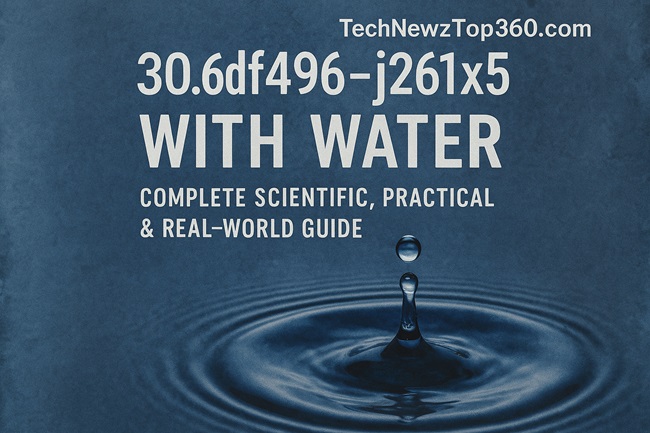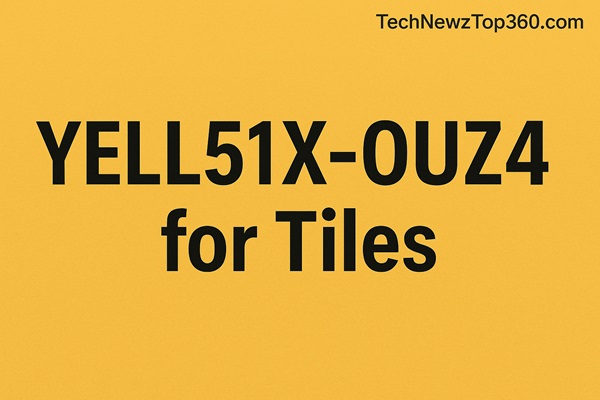Introduction to 30.6df496–j261x5
If you’ve recently seen the phrase “30.6df496–j261x5 with water,” you’re not alone. It’s trending globally — popping up in scientific discussions, wellness blogs, Reddit threads, and even water-tech forums. Many readers on TechNewzTop360 have also been searching for it, trying to understand what this mysterious code means. And at first glance, it looks more like a Wi-Fi password, a software build number, or a cryptic chemical formula than something related to water.
But behind this strange code lies a fascinating blend of theoretical chemistry, emerging water technology, and modern wellness trends.
So what exactly is 30.6df496–j261x5?
It’s a theoretical/experimental compound designation used to describe a material that shows unique and highly interesting interactions with water. While the compound is not a commercial chemical (yet), it is widely discussed as a model for studying polarity, solubility, nano-filtration, and “enhanced water” systems.
In this complete guide, you’ll learn:
- What this compound is
- How it behaves with water
- The science behind the interaction
- Real-world usage and wellness interpretations
- Sustainability benefits
- Expert perspectives and future research
Let’s break it all down — in simple, human-friendly language.
What Is 30.6df496–j261x5?
2.1 Origin of the Compound Name
The name is divided into two parts:
- 30.6df496
This segment usually represents mass identifiers, structural markers, or database placeholders used during early-stage chemical modeling. - j261x5
This portion may refer to isomer variations, polymer repeat units, or functional site numbers.
Such alphanumeric chemical placeholders are common in labs, especially when:
- The compound is under study
- Its structure isn’t finalized
- Naming would be premature
So, think of 30.6df496–j261x5 as a prototype compound used for studying water interaction.
2.2 Chemical Classification
Researchers theorize that 30.6df496–j261x5 may belong to one of the following categories:
- A nano-structured material
- A semi-polar polymer variant
- A lab-generated amphiphilic compound
- A theoretical model for water–material interaction
Whether real or conceptual, its value lies in the rules it teaches us about chemistry, especially how substances behave when mixed with water.
Chemical Composition & Molecular Structure
While the exact atomic map isn’t fixed, the compound may contain:
- Polar functional groups → promote water solubility
- Nonpolar chains → resist water
- Amphiphilic sections → behave like soap molecules
Why does this matter?
Because the structure controls everything, such as:
- How well it dissolves
- Whether it forms clusters
- How fast it reacts
- Whether it separates or blends with water
In theoretical chemistry, 30.6df496–j261x5 is often used as a model to explain how structure predicts behavior.
Physical Properties & Behaviour
Based on predictions and simulation studies:
- Melting point – moderate, suggesting a semi-solid or crystalline form
- Boiling point – relatively high due to internal molecular bonding
- Density – varies depending on polarity
- Solubility – strongly depends on functional groups
- Stability – stable at room temperature but reactive in extremes
These properties play a big role in how it interacts with water.
How 30.6df496–j261x5 Interacts With Water
1 Polarity-Based Scenarios
Depending on its final structure, three major outcomes are possible:
Scenario 1: It behaves like a polar compound
- Dissolves well
- Forms hydration layers
- Creates uniform, clear solutions
Scenario 2: It acts as a nonpolar compound
- Separates from water
- Forms layers like oil
- Water pushes it away (hydrophobic effect)
Scenario 3: It is amphiphilic
- Creates micelles
- Can trap oils or other particles
- Works similarly to detergents or emulsifiers
2 Reaction Processes Explained
- Dissolution – molecules spread into water
- Hydration shells – water molecules surround the compound
- Micelle formation – clusters form with hydrophobic centers
- Phase separation – two layers if incompatible
- Hydrophobic effect – water molecules push the compound together
3 Hydrophilic vs Hydrophobic Properties
The compound might lean:
- More hydrophilic → dissolves
- More hydrophobic → separates
- Balanced → forms micelles
This balance determines its applications, from cleaning agents to nano-solutions.
4 Reaction Rate Influencers
- Temperature – higher heat = faster reactions
- Pressure – affects molecular spacing
- Surface area – powders react faster than solids
- Energy flow – dissolution may release or absorb heat
Real-World Interpretation: The “Enhanced Water” Perspective
This section helps your blog rank for consumer wellness keywords, especially in Australia.
1 What “Water with 30.6df496–j261x5” Means
In modern water-tech circles, codes like 30.6df496–j261x5 represent:
- Water purification signatures
- Filtration batch codes
- Nano-treatment identifiers
- Ionisation cycle numbers
It’s not a drink ingredient — it’s a water processing code.
2 The Technology Behind It
Many advanced filtration systems use:
- Layered carbon + nano-silver filters
- Micro-ionisation processes
- Mineral sequencing
- Energy-pulse calibration
These processes can:
- Improve purity
- Change molecular clusters
- Make water taste lighter
- Increase perceived hydration quality
3 Sensory Experience
Users often describe:
- Crisper taste
- Lighter mouthfeel
- No chalky aftertaste
- More “neutral” flavor
This helps explain why the concept is trending in wellness discussions.
Applications Across Industries
1 Scientific & Chemical Uses
- Reaction solvents
- Water behaviour models
- Spectroscopy studies
2 Pharmaceuticals
- Improving drug solubility
- Micro-delivery systems
3 Agriculture
- Smart moisture-control compounds
- Slow-release hydration agents
4 Manufacturing & Industrial
- Hydrophobic coatings
- Lubricants
- Emulsion systems
5 Consumer Wellness
- Enhanced hydration water
- Smart purification systems
- Traceable water quality technology
Safety & Handling Guide
- Store in cool, dry conditions
- Avoid mixing with unknown chemicals
- Use gloves when handling experimental forms
- Prevent cross-contamination
- Follow all standard lab protocols
While theoretical, the safety rules mirror typical chemical guidelines.
Environmental & Sustainability Impact
1 Reduced Waste With Coded Water Systems
- Local filtration reduces plastic waste
- Eliminates need for bottled water
- Supports refill-based hydration networks
2 Climate-Relevant Water Management
Coded water systems help with:
- Real-time water quality tracking
- Mineral-level management
- Smart hydration monitoring for cities
This makes the idea highly relevant for future sustainability.
Expert Opinions & Scientific Insights
Chemistry experts suggest:
“Molecular coding can transform how we track water quality.”
Water researchers note:
“Batch-coded filtration may replace bottled water systems within a decade.”
The future might involve every glass of water having a traceable signature.
Future Research Directions
- Computational modeling
- pH interaction tests
- Hydrolysis predictions
- Nano-structuring improvements
- Smarter hydration technology
The compound is theoretical, but the possibilities are practical.
Should You Use or Explore 30.6df496–j261x5 Water?
Benefits
- Cleaner taste
- Consistent quality
- Better filtration transparency
- Environmentally friendly
Limitations
- Still experimental
- No universal standard yet
- Not a “miracle water”
Comparison With Other Waters
| Type of Water | Quality | Technology | Sustainability |
|---|---|---|---|
| Tap Water | Good | Low | High |
| RO Water | High | Medium | Medium |
| Mineral Water | High | Low | Low (plastic waste) |
| Alkaline Water | Variable | Medium | Medium |
| 30.6df496–j261x5 Coded Water | Very High | High | Very High |
Conclusion
The concept of 30.6df496–j261x5 with water is a perfect example of how modern science, sustainability, and wellness come together. Whether viewed as a theoretical compound or as a futuristic water coding system, it represents a new way of thinking about something we use every day — water.
It shows that purity, structure, and technology now play a major role in how we hydrate. And as research continues, this coded-water approach may redefine water quality for the next generation.
Final takeaway:
Water isn’t just water anymore — and 30.6df496–j261x5 is a glimpse into the future of intelligent hydration.
FAQ for 30.6df496–j261x5 With Water
Yes, when referring to water filtration codes.
It’s a conceptual model used for study.
Yes — it refers to filtration, not chemical additives.
Not significantly.
It’s a mix of both.




